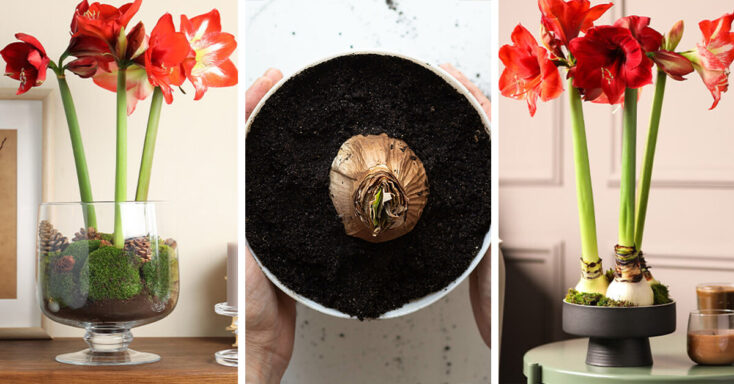Amaryllis is one of those flowers that’s striking in any garden. They have cheery, bright flowers that attract the eye. The wonderful thing about Amaryllis is that they bloom into winter when everything else is barren. This guide is here to teach you everything about proper amaryllis care.
Amaryllis Admiration
The two key matters in growing Amaryllis successfully are warmth and watering. What was once a plain bulb becomes a wonder to behold. Sitting in a field of Amaryllis energizes creativity. Their trumpet-shaped flowers pose to announce their arrival at the top of 1-2 leafless scapes. They make a lovely housewarming gift suited to even beginner gardeners.
The name Amaryllis comes from the Greek amarysso, meaning “to sparkle.” How apt! With flowers measuring 4-10 inches wide with single or double blooms, they certainly stand out.
Fertilized flowers bear fruits with brown or black seeds. The two leathery leaves on Amaryllis measure about 2 feet in length. In their native habitat, they would have a period of dormancy, but breeding changed all that. Modern bulbs do not need to rest.
Amaryllis Myth: Amaryllis was a nymph in Greek stories. She was very much in love with a shepherd named Aleto. Wishing to win his adoration, she used a golden arrow to pierce her heart. For 12 days, she visited his cottage, dripping blood along the path. On day 13, the drops blossomed into glorious red flowers on the pathway. Aleto became quite enamored, and his love healed her wound.
Key Takeaways
- The two most popular Amaryllis colors are red and white.
- Under prime circumstances, Amaryllis can be an “evergreen” plant.
- The perfume industry uses Amaryllis oil as a relaxing aromatic.
- Amaryllis does not require a lot of detailed effort to grow and care for the flower.
Amaryllis Care 101
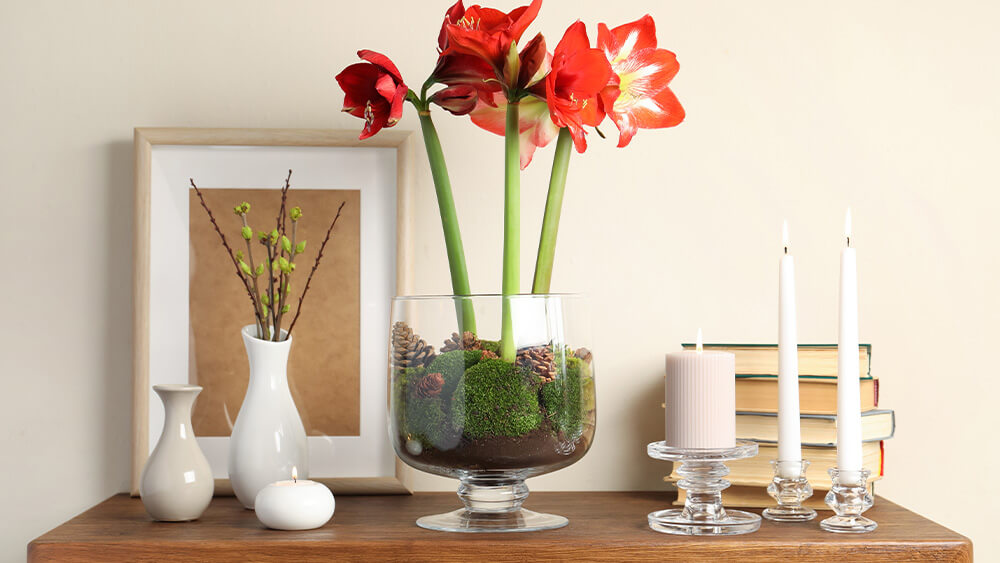
Begin by giving your Amaryllis a healthy potting media. Put its pot in an area with indirect light and give it water. It helps to provide a steak, giving the lanky flowers extra support. You should see signs of growth within 6 to 10 weeks.
The plant requires a 6-8 inch pot with good drainage holes. The flowers are heavy, so getting a sturdy container like terracotta that won’t be prone to tipping over is wise. Plant the bulbs point up with about ⅓ of the bulb peeking above the soil line.
When the top two inches of soil feel dry, it’s time to water your Amaryllis. Give it a good soaking, then drain completely. Repeat as necessary. Over time, you’ll have a feel for your specific plant’s watering rhythm.
Bulky Bulbs: When you think of a flower bulb, you might immediately imagine something like a tulip bulb. By comparison, Amaryllis are hefty, measuring about the size of a tightly closed fist or a tennis ball. The bulb size supports the two flower stalks, each of which can bear up to five flowers. If you have your choice of bulbs, go big! It takes 3-5 years before an Amaryllis bulb is marketable. As a result, they can be rather expensive.
Amaryllis Needs
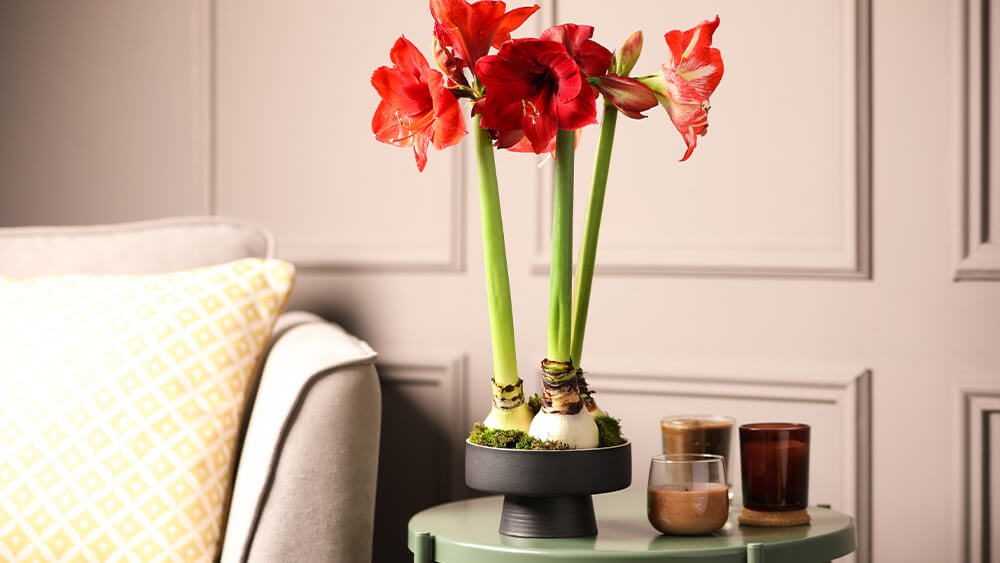
If you keep your plant healthy well into summer, it will blossom later in the season. Begin with a tight container and prepare to repot every 3-4 years. An Amaryllis needs are few, and you can get spectacular results with minimal effort.
Start with a pot that’s one inch wider than the bulb. Use everyday potting soil (10-20-15)—no need for a fancy blend here. Water carefully. When Amaryllis bulbs sit in water too long, they begin to rot. However, when the plant begins growing, you’ll notice the soil dries out more quickly. Liquid fertilizer encourages leaf production. Healthy leaves = healthy flowers. They’re a team. Go with half strength as often as you water.
You can grow Amaryllis from seed if you are a very patient gardener. Once grown to maturity, many seeds end up looking nothing like the mother plant. It will take about six years before the bulb is big enough to produce flowers.
Buying Amaryllis for Your Indoor Garden
For the discerning homeowner, there are hundreds of amaryllis varieties. You can find pink, green, yellow, orange, burgundy, purple, and even multi-colored blossoms. You can also find double-flowered versions.
- Apple Blossom: A single white flower with pink blush and red lines. Grows 1-2 feet tall, producing 4-6 flowers atop 2-3 stems.
- Barbados: This Amaryllis is lipstick red with a white-striped center. It has a showy span of 6-8” flowers—an excellent choice for indoor gardens.
- Bogota: Spidery flowers with a unique feature. The top side of the blossom is deep red, and the bottom is a deep salmon—flower width: 51/2 inches.
- Christmas Gift: Pure White. This Amaryllis looks like fresh snow. If you want impressive flowers, Christmas gift “gifts” you with 7-inch blossoms, sometimes bigger. You can depend on this plant for performance.
- Dancing Queen: Reminiscent of peppermint with double red and white striped flowers. It’s frilly as if dressed for the ball. Flowers measure up to 9”
- Evergreen: As the name implies, the Evergreen Amaryllis bears lime green to mint green, spider-type flowers.
- Gervase: An Amaryllis that can’t quite settle on color. These range from white to dark pink, red stripped, and feathering! Big flowers measuring 8”. There is veining in each flower, akin to a fingerprint.
- Marilyn: Layers upon layers of pure white petals with a pale yellow heart. Grows to 2 feet tall featuring 8” ruffled flowers as shapely as the movie star.
- Minerva: The dark, cherry-red edges highlight a white petal. The center of each flower has a white star and green throat. Grows to be about 20 inches tall with 2-3 stems and 4-6 flowers.
- Monte Carlo: The Monte Carlo features six white petals framed with a glorious deep pink. Usually produces two stems with four blooms.
- Naked Ladies: They get their name due to the fact that they blossom before a plant develops its leaves. Pale pink with burnt-orange centers.
- Picotee: A flower perfectly tailored with a delicate red border and white interior. It takes a while for this Amaryllis to blossom, but once it does, you’re rewarded with heavy blooms measuring 7”.
- Red Lion: An aptly named flower, looking like a red lion’s mane. A beautiful addition to a pot of pastel-colored flowers. Grows up to 18” with 7” blossoms.
Amaryllis is also called the Belladonna Lily, Easter Lily, Amarillo, Jersey Lily, and March Lily since many of these plants blossom in March (or thereabouts).
Watering Techniques for Indoor Amaryllis
Once your Amaryllis starts sprouting, water it from the top using room-temperature water. Continue water as needed until after the plant flowers. Now you can let your plant go dormant, resting up for another round of flowers. In fact, the bulb tells you it’s ready for a rest with yellowing leaves. A resting period of 2-3 months is a good goal. Start watering them again, and new sprouts appear. You’ll find Amaryllis is thirsty, with its soil drying out more quickly than you might expect.
Look Mom, No Hands! Waxed versions of Amaryllis do not need water or even soil to blossom! The wax holds in everything they need to flower. For the interior designer inside, this means you can come up with creative ways of displaying this Amaryllis, including hanging it from the ceiling! You place a hood into the base and hang it where you wish.
Amaryllis Potting and Repotting
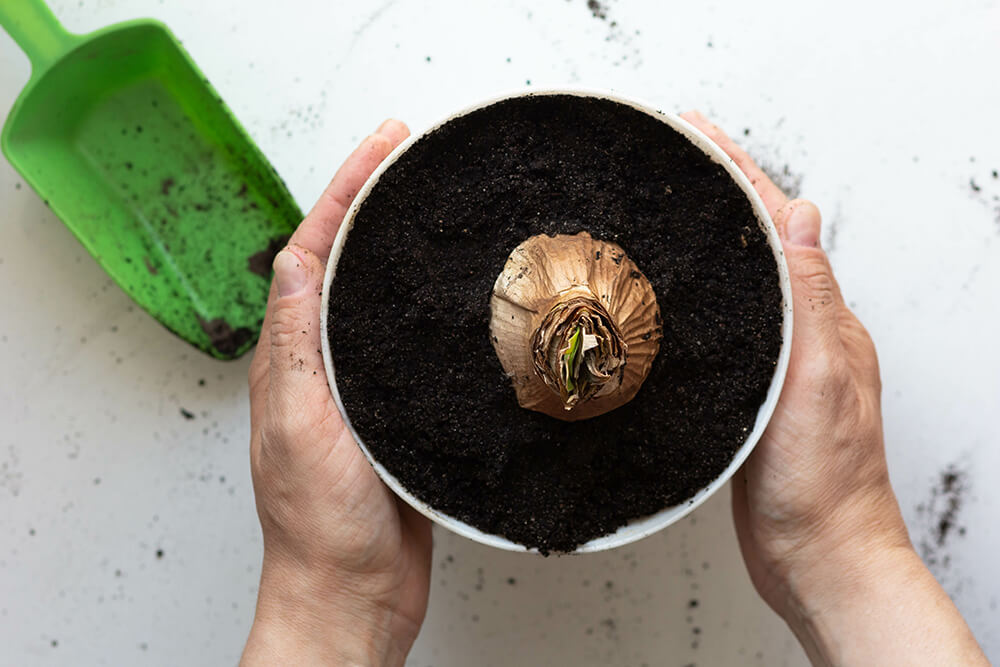
When you shop for amaryllis, you’re looking for the largest bulb you can find. Such a bulb will generally be produced in the first year. The larger the bulb, the more flowers you get. Make sure it has no visible signs of decay or injury. If the bulb already has new growth started, it should be bright green.
Place the bulb into a container 1” wider and twice as tall as the bulb itself. Fill the pot with a mix of potting soil and peat moss. The bulb rests on top of the mount, with the roots on the soil. Add more soil and tap it down as you go for security. Give the Amaryllis a thorough watering in a sink, stopping when the water comes out of the drainage hole. Let it drip dry before placement in a sunny window.
Repotting works similarly, but for removing the plant from its original container, loosening the roots a bit, and placing the plant into its new home.
Because the flowers stand high and straight, they represent determination and strength. The Victorian Language of Flowers added the meaning of sturdiness and success. Each color of Amaryllis has a slightly different symbolism. Yellow is an emblem of happiness and luck, red – passion and love, and orange is positive energy. Purple is the color of nobility and spirituality, and pink signifies friendship.
Amaryllis Pruning and Maintenance
Once an amaryllis flower fades, snip it off, leaving the stalks. They continue providing nutrients for the next blooming. Continue leaving your plant in partial sunlight. Inevitably, the stalks wither and leafs yellow. Trim them to the top of the bulb. Your plant is ready for a dormant period.
You can leave your pot in a dark, cool (40-50F) location for 2-3 months before it’s ready to grow again. Gardener’s tip: Your refrigerator is not a suitable storage space for bulbs. It will sterilize the plant.
Age of Amaryllis: It’s probable that Amaryllis bulbs arrived in Europe around the 16th century, carried by the Portuguese. From here, travelers from Spain and Italy encountered the plant, considered a treasure worthy of taking home.
Blooming and Resting Periods with Amaryllis
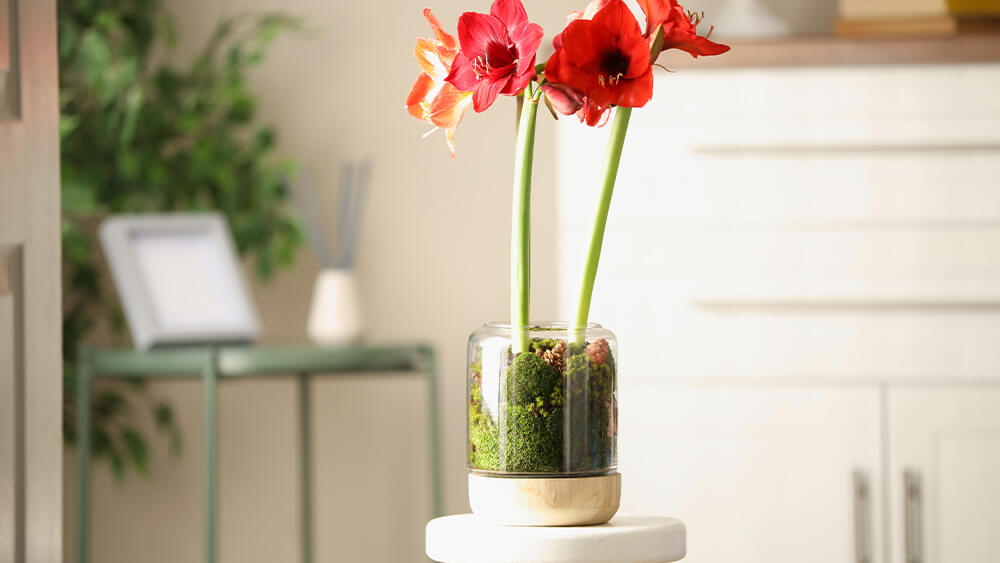
Your indoor Amaryllis doesn’t require a dormant period. If you let them grow, they will bloom again. Having said that, letting them go dormant allows you to control bloom times. In order for your Amaryllis to re-bloom, the cool periods to rest. A space with a temperature around 50F is ideal. When you take this step, avoid watering the plants.
If you notice the plant starting to grow again, put it back in a sunny window and start its watering cycle again. Within 4-6 weeks, flowers should begin.
Amaryllis attracts carpenter bees, which are excellent pollinators.
Amaryllis Common Pests & Plant Diseases
Thankfully, there aren’t a lot of threats to indoor Amaryllis. There are a few you might encounter. One is a narcissus bulb fly. It lays its eggs in amaryllis bulbs if you put your plant outdoors for the summer. The larvae mulch on the interior of the bulb. On the outside, the plant looks wilted and distorted. Sadly, you may not be able to control this issue before the plant has no chance.
Red blotch is another disease. The plant develops red cankers at the base of the flower stalks and new leaves. Battle this with fungicide.
Want to Live Forever? While it might not be an eternal plant, Amaryllis has the total capacity to live up to 75 years. These ancient plants have six-inch diameters.
Troubleshooting Common Problems
There are a few issues many gardeners report about Amaryllis.
- Overwatering. They like moist soil, but when the soil stays saturated, it welcomes root problems and attracts some pests. You’re dealing with overwatering if you have yellowing leaves and stunted growth. Let the plant dry out completely between watering.
- Lack of flowers: One common natural problem is the plant is done flowering and moving into dormancy. If your plant gets too much or too little light or water, it affects growth.
- Wilting, sinking leaves: A sign of low light conditions. While the leaves remain green, they start bending. Move your Amaryllis to a sunnier location. Conversely, if you see browning tips, your plant is getting too much direct sun.
The Worsleya procera is one of the most sought-after amaryllis bulbs. Combin from Brazil, where it grows on cliff sides facing the sun and wind, this bulb produces striking lilac-blue flowers. The seeds from this Amaryllis do not last long before they will not produce whatsoever (about 9-10 months).
Frequently Asked Questions About Amaryllis Care and Keeping
What do you do with an amaryllis bulb after it has bloomed?
After the flower fades, cut it down using pruners to about 1-2” above the bulb. Do not disturb the foliage. The leaves continue feeding the plant.
How do you keep an amaryllis for next year?
To successfully keep your amaryllis for the next season, trim away obviously dead leaves 1-2” above the bulb. Water the soil as you would normally. Provide some fertilizer, which helps it create new flowers. Store the bulb in a cool, dry, dark location for 12 weeks.
When should I put amaryllis in the dark, and for how long?
When it's ready for its dormant period. The temperature in the area should be around 55F. Let the plant rest for 8-12 weeks.
Do amaryllis like sun or shade?
Amaryllis, close to blooming, benefits from a sunny location 6-8 hours daily. The more sun at the point results in bigger blossoms.
Everything You Need to Know About Amaryllis Care
Amaryllis is a forgiving plant and one well-suited to beginner gardeners. The tall, elegant flowers make a fantastic showpiece for your indoor landscape. There are many cultivars from which to choose, one of which should appeal to your ascetics. If you care for Amaryllis properly, you can enjoy them for many years to come.

